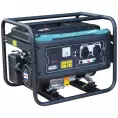FACOM AUTOMOTIVE MULTIMETER
FACOM
Reference 1911324
Are you interested in this product?
Become a customer and benefit from
- A catalogue of over 300,000 references
- Dadvantageous tariff conditions
- Responsive and available customer service
-
Turnkey services to support you
on a daily basis
Description
- In electricity, the FACOM multimeter remains the indispensable complement to the "diagnostic cases".
In addition to the traditional measuring functions: Voltmeter, Ammeter, Ohmmeter.
Specialised functions for vehicle inspections have been added.
For checking EGR valves, petrol injectors, turbocharger discharge controls.
To detect a battery fault that causes voltage level fluctuations.
In some vehicles, these fluctuations cause electronic equipment to malfunction.
Allows control of Lambda regulation.
The rev counter and cam angle functions allow older vehicles with non-electronic ignitions to be adjusted.
The 714A is class III 600V, which allows to work on hybrid and electric vehicle network voltages.
(Subject to compliance with current procedures and regulations).
Measurement of the internal resistance of batteries.
Automatic calibration.
Voltmeter : AC / DC 0 --> 600 V.
Ammeter : AC / DC 0 --> 400 mA.
Ohmmeter : 0 Ω --> 40 MΩ.
Continuity and diode test.
Temperature measurement. Duty cycle: 5% --> 99%.
Cam angle.
Rev counter.
Frequency meter: 1 Hz --> 400 Khz.
Compatible with the current clamp Ref 711A.P500.
Advices
- To avoid electric shock or injury, follow these instructions:
- Do not use the multimeter if it is damaged. Before using the instrument, inspect the case. In particular, check the insulation around the terminals.
- Check that the insulation on the test leads is not damaged or that there are no exposed metal parts. Check the continuity of the test leads. Replace damaged test leads before using the unit.
- Do not use the unit if its operation is abnormal. The protection may be impaired. If in doubt, send the device for repair.
- Do not use the device in an explosive environment (presence of gas, vapour or dust). Do not use the unit in explosive environments (gases, vapours or dust) or in damp conditions.
- The voltage applied between terminals or between a terminal and earth must not exceed the rated voltage marked on the unit.
- Before use, check the operation of the unit by measuring a known voltage.
- For a current measurement, switch off the circuit before connecting the multimeter. Remember to connect the multimeter in series with the circuit.
- When repairing the unit, use only specified spare parts.
- Take all necessary precautions when working with voltages above 60 Vdc, 30 Vac rms or 42 V peak as there is a risk of electric shock:
- When using the probes, protect your fingers by holding them to the back of the guards provided on the probes.
- When connecting, connect the common test lead first and then the live test lead. When disconnecting the test leads, disconnect the live test lead first.
